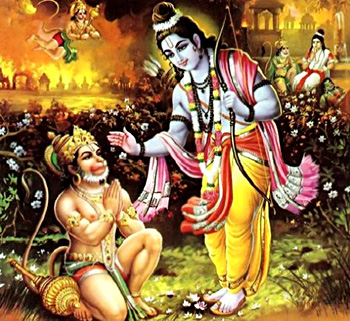 Hanuman returns to Rama after burning the half of Lanka. When the tail of Hanuman was set on fire, Hanuman jumped from one place to another, burned the kingdom of the demon king Ravana, and killed a large numbers of rakshasas. After burning the half of the kingdom of Lanka he quenched his tail in the sea and went to have a final look at Sita. He met Sita in the Ashoka Vatika, greeted her, and told her that she would be soon rescued by Rama. Thus he departs Lanka in order to meet Rama, Lakshmana, Sugriva and the other monkeys and the great bear Jambavan.
Hanuman returns to Rama after burning the half of Lanka. When the tail of Hanuman was set on fire, Hanuman jumped from one place to another, burned the kingdom of the demon king Ravana, and killed a large numbers of rakshasas. After burning the half of the kingdom of Lanka he quenched his tail in the sea and went to have a final look at Sita. He met Sita in the Ashoka Vatika, greeted her, and told her that she would be soon rescued by Rama. Thus he departs Lanka in order to meet Rama, Lakshmana, Sugriva and the other monkeys and the great bear Jambavan.
Hanuman sprang up like a winged mountain and flew across the sea, which was clearly seen and sometimes hidden by the clouds, till he reached the Mahendra. Flourishing his tail and roaring like the wind in a mighty cavern he stood on the mountain. After seeing Hanuman return from Lanka, the monkey host jubilated exceedingly, knowing that he must have found Sita. The monkeys danced, and ran from peak to peak, and waved the branches of trees and their clean white cloths, and brought fruits and roots for Hanuman to eat. Then Hanuman narrated all that he had done to Angada and Jambavan, while all the monkeys sat round the three on the summit of Mahendra.
When everything was told to them, Angada turned to the monkey host and told then that their work has been done and the time has come for them to return to Sugriva without any delay. Then Angada sprang up into the air, accompanied by all the monkeys, darkening the sky like clouds and roaring like the wind; and coming hurriedly to Sugriva, Angada spoke first to the heavy-hearted Rama, and gave him tidings of Sita and praised the work of Hanuman. Rama then talked with Hanuman, asked him several questions about the welfare of Sita, and Hanuman told him all, gave her message regarding the matter of the crow and of the painted brow-spot, and showed to Rama the jewel from Sita`s hair entrusted to him as a token. Rama wept after seeing the goodly gem, but he rejoiced to know that Sita lived and that Hanuman had found her.
Rama then praised Hanuman for his good deeds, which had done more even than was required of him. He told the Hanuman had done his work and more and then Rama embraced the self-controlled and greathearted Hanuman like a brother. Then, Sugriva spoke and gave orders for a march of all the army of monkeys towards the far south to lay a siege to Lanka, while Hanuman reported to Rama the entire thing that he had learnt of the strength and fortifications of the city of Lanka.
Thus, all the monkey army went on its way, led by Sugriva and Rama along with Lakshmana, and the monkeys skipped with joy, bounded gleefully, and sported one with another. With them went many friendly bears, ruled by Jambavan, guarding the rear. After crossing a number of mountains and delightful forests, the army came at length to Mahendra, laid eyes on the sea before them, marched to the very shore, beside the wave-washed rocks, and made their camp. They covered the entire shore like a second sea beside the tossing waves. Then Rama called upon a council to invent a means for crossing over the ocean, and a guard was set, and orders were issued that no one should wander, since they feared the magic of the rakshasas.



















